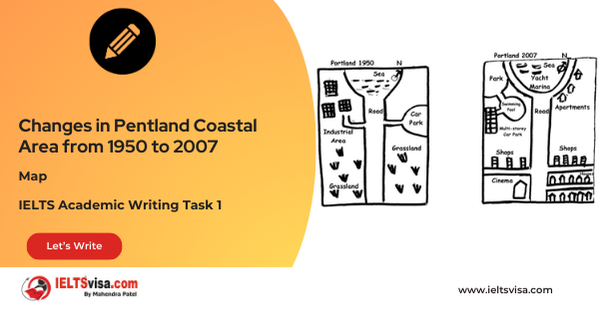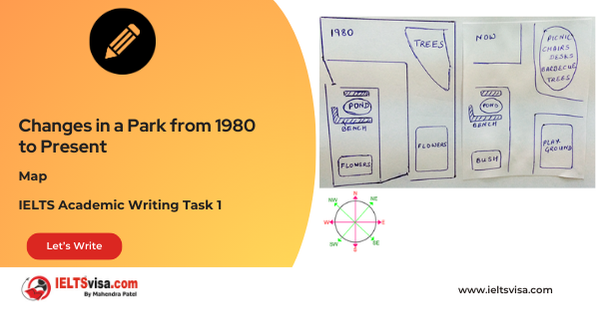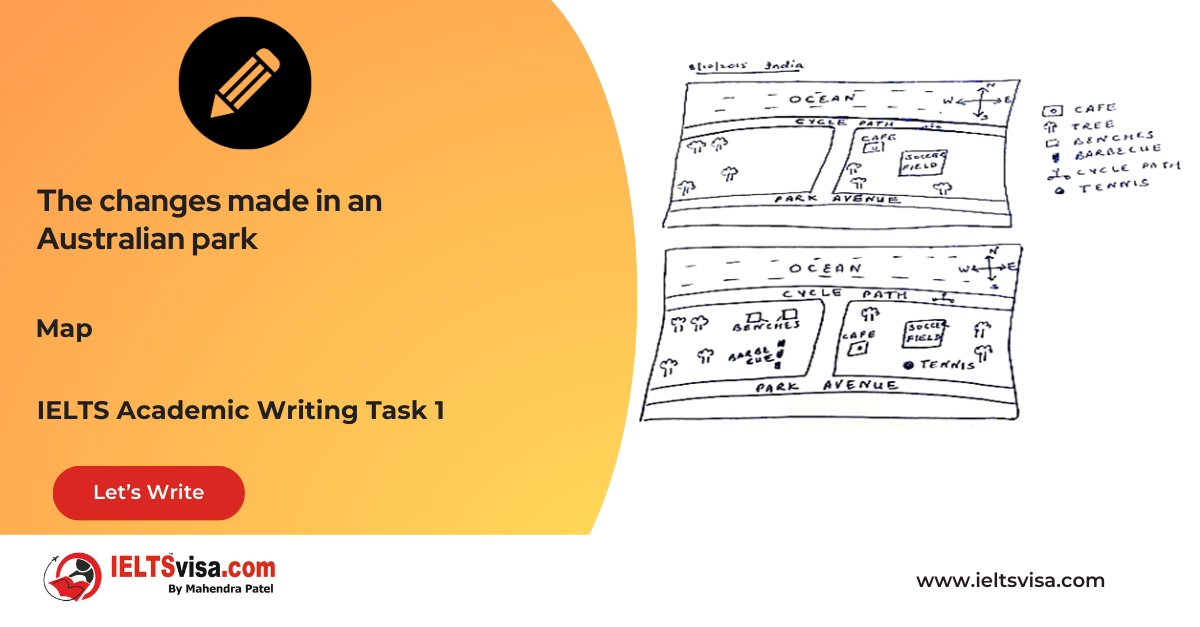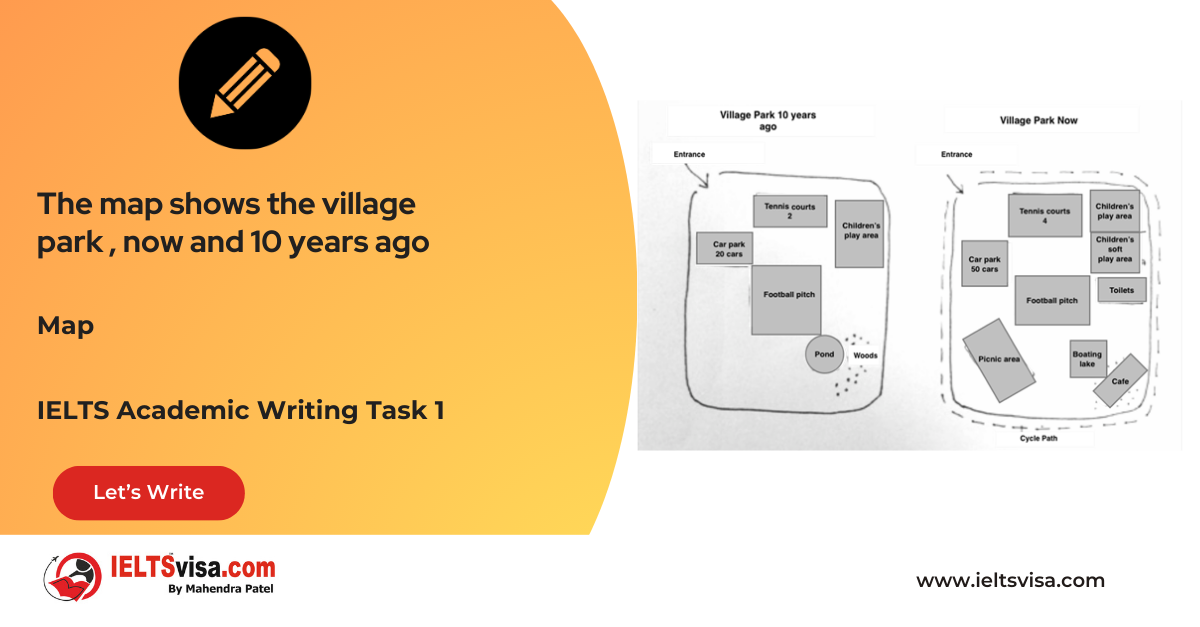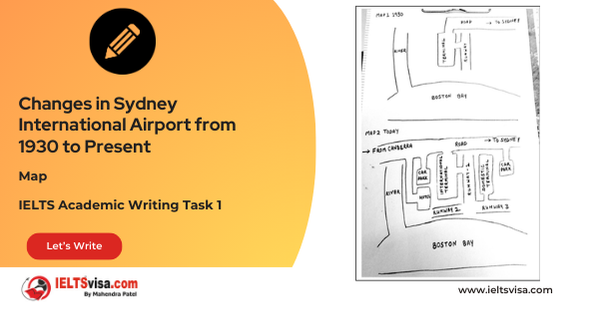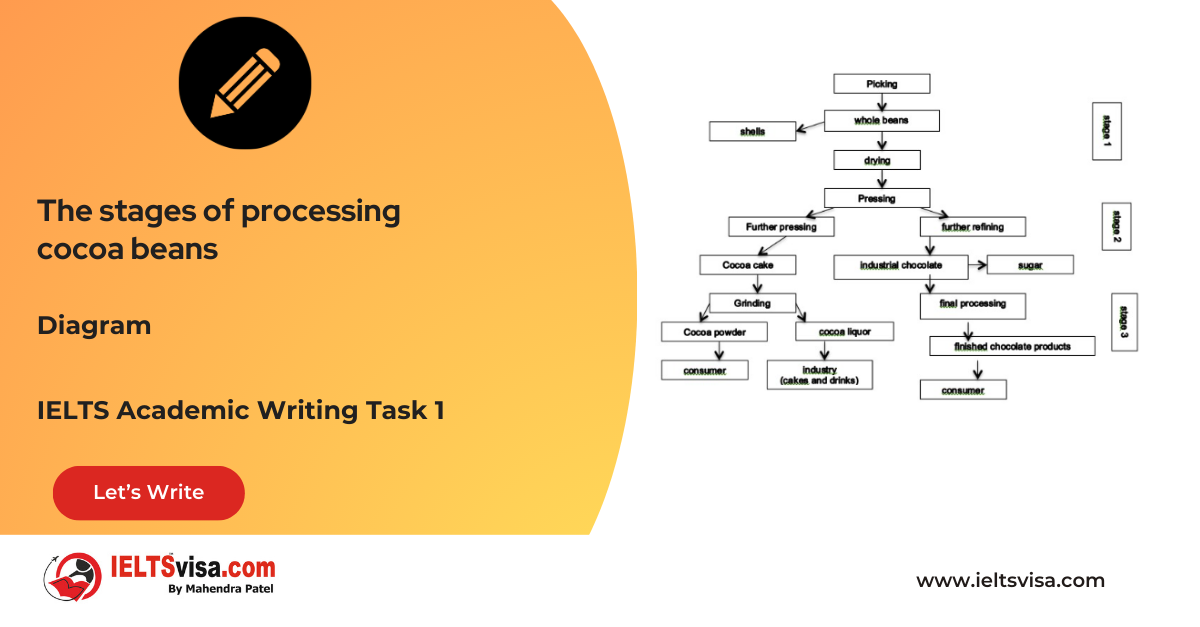The population of three cities in 1990, the population forecast of 2000 and the actual population of 2000
IELTS Academic Writing Task 1 - Tables
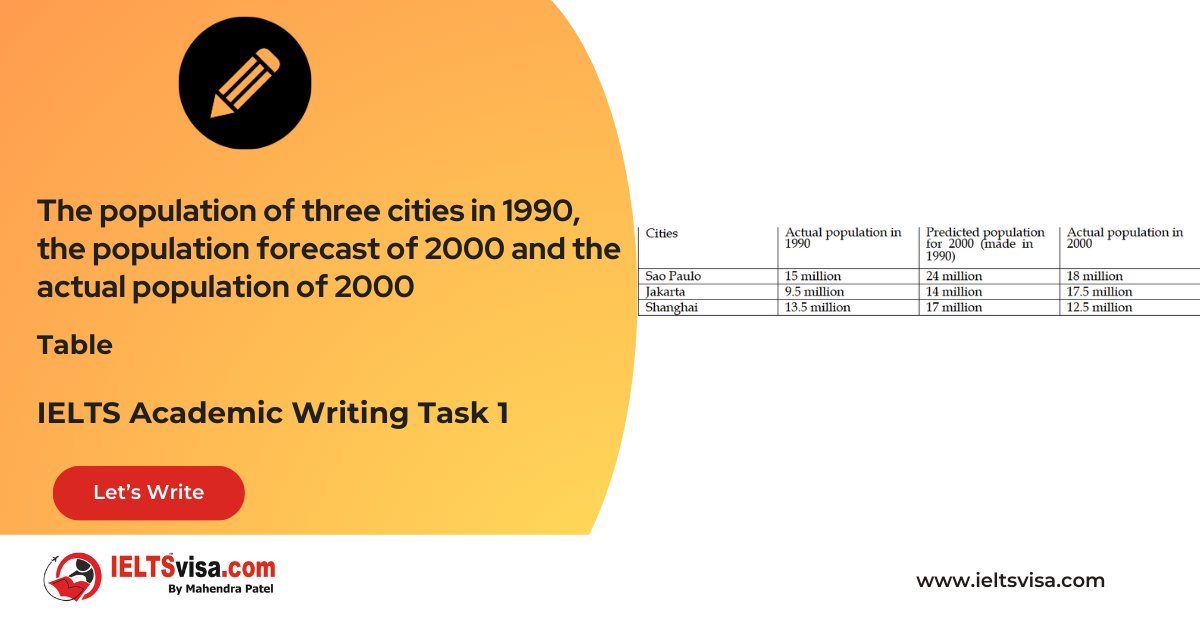
IELTS Writing Task 1 Question
The graph below shows the population of three cities in 1990, the population forecast of 2000 and the actual population of 2000. Summarise the information by selecting and reporting the main features and make comparisons where relevant.

Common Questions for the Table
1. Graph Type: Table
2. Title: Population and Forecasted Population of Three Cities in 1990 and 2000
3. What are the units of measurement?: Number of people (in millions)
4. Who: Populations of three cities (Sao Paulo, Jakarta, and Shanghai)
5. When: Years 1990 and 2000
6. Where: Cities in Brazil (Sao Paulo), Indonesia (Jakarta), and China (Shanghai)
7. Topic: Comparison between the actual and forecasted population figures for three cities over a decade
Comparison Showing and Trends Any change over time (such as an increase or a decrease) is a trend.
Comparison 1 : Actual vs Predicted Population in 2000
- Details:
1. Sao Paulo’s actual population (18 million) was 6 million less than predicted.
2. Shanghai’s actual population in 2000 (12.5 million) was lower than the forecast (17 million).
3. Jakarta’s actual population exceeded the forecast, rising to 17.5 million.
Comparison 2 : Changes from 1990 to 2000
Details:
1. Sao Paulo’s population increased from 15 million to 18 million.
2. Jakarta’s population almost doubled from 9.5 million to 17.5 million.
3. Shanghai’s population decreased slightly from 13.5 million to 12.5 million.
Sample Answer
The given table outlines the population figures of Sao Paulo, Jakarta, and Shanghai in 1990 and compares the actual population with the predicted figures for 2000. It is evident that the population forecasts made in 1990 did not align with the actual outcomes.
In 1990, Sao Paulo had the highest population at 15 million, followed by Shanghai at 13.5 million and Jakarta at 9.5 million. By 2000, the population of Sao Paulo was expected to reach 24 million but only increased to 18 million—6 million less than predicted. Jakarta’s population was forecasted to grow by 4.5 million but actually surged to 17.5 million, nearly double its 1990 figure. Conversely, Shanghai’s population was predicted to rise moderately to 17 million, but unexpectedly, it decreased to 12.5 million.
Overall, while Sao Paulo and Jakarta experienced significant population growth, Shanghai’s population declined. The predictions made in 1990 overestimated the growth in Sao Paulo and Shanghai, whereas Jakarta’s actual growth far exceeded expectations.
Top 28 Vocabulary
| Vocabulary | Type | Meaning | Synonyms | Examples |
|
Forecasted |
Adjective |
Predicted or estimated |
Projected, anticipated |
“The forecasted population of Jakarta was exceeded by the actual figures.” |
|
Surged |
Verb |
Increased suddenly |
Soared, spiked |
“Jakarta’s population surged to 17.5 million in 2000.” |
|
Exceeded |
Verb |
Went beyond expectations |
Surpassed, outstripped |
“The actual population exceeded the predicted figure.” |
|
Align |
Verb |
Match or agree with |
Correspond, concur |
“The predictions did not align with the actual data.” |
|
Moderately |
Adverb |
To a certain extent |
Reasonably, slightly |
“Shanghai’s population was expected to grow moderately.” |
|
Outlined |
Verb |
Summarized or presented the main points |
Described, Highlighted |
“The table outlined the population figures of three cities in 1990.” |
|
Figures |
Noun |
Numerical data or statistics |
Numbers, Statistics |
“The population figures show a significant increase for Jakarta.” |
|
Predicted |
Verb |
Estimated to happen in the future |
Forecasted, Projected |
“The predicted population for Sao Paulo in 2000 was 24 million.” |
|
Outcomes |
Noun |
Results or consequences |
Results, Consequences |
“The outcomes of population growth varied between the cities.” |
|
Exceeded |
Verb |
Went beyond or surpassed |
Surpassed, Outperformed |
“Jakarta’s population exceeded expectations by a large margin.” |
|
Declined |
Verb |
Decreased in size, amount, or importance |
Reduced, Dropped |
“Shanghai’s population declined unexpectedly by 2000.” |
|
Estimated |
Verb |
Roughly calculated or judged |
Assumed, Approximated |
“The estimated growth for Shanghai did not match reality.” |
|
Unexpectedly |
Adverb |
Not as anticipated |
Surprisingly, Unpredictably |
“Shanghai’s population unexpectedly decreased to 12.5 million.” |
|
Significant |
Adjective |
Important or notable |
Substantial, Considerable |
“Sao Paulo experienced significant population growth.” |
|
Growth |
Noun |
Increase in size or development |
Expansion, Rise |
“Jakarta witnessed rapid population growth between 1990 and 2000.” |
|
Forecasts |
Noun |
Predictions or estimations of future trends |
Projections, Predictions |
“Population forecasts for Sao Paulo were overestimated.” |
|
Actual |
Adjective |
Real or existing |
Real, Factual |
“The actual population figures for Jakarta were much higher than predicted.” |
|
Comparison |
Noun |
The act of examining similarities and differences |
Contrast, Juxtaposition |
“The table provides a comparison of predicted and actual figures.” |
|
Overestimated |
Verb |
Assumed something to be larger or greater than it is |
Exaggerated, Misjudged |
“The growth in Sao Paulo was overestimated by 6 million.” |
|
Far exceeded |
Verb Phrase |
Greatly surpassed |
Greatly outpaced |
“Jakarta’s growth far exceeded the forecasted figures.” |
|
Decline |
Noun |
A reduction or drop in number |
Decrease, Reduction |
“Shanghai saw a decline in its population by 2000.” |
|
Marked |
Adjective |
Noticeable or clear |
Distinct, Evident |
“There was a marked increase in Jakarta’s population.” |
|
Contrary |
Adjective |
Opposite to what was expected |
Opposite, Opposed |
“Contrary to predictions, Shanghai’s population decreased.” |
|
Surpassed |
Verb |
Went beyond in amount or degree |
Exceeded, Outperformed |
“Jakarta’s population growth surpassed the predictions made in 1990.” |
|
Population trends |
Noun Phrase |
Patterns in population growth or decline over time |
Demographic changes |
“Population trends reveal a steady increase in Jakarta.” |
|
Unexpected |
Adjective |
Not anticipated |
Surprising, Unforeseen |
“The decline in Shanghai’s population was unexpected.” |
|
Moderate |
Adjective |
Average or reasonable in degree |
Modest, Medium |
“Shanghai was expected to experience moderate growth.” |
|
Variation |
Noun |
A change or difference in condition or amount |
Fluctuation, Difference |
“There was a significant variation between predicted and actual figures.” |

Our Books
Master IELTS Speaking Part 1
IELTS Writing Task 1 Book
IELTS Writing Task 2 Book
Writing Task 1 Question Types
Practice IELTS Other Modules
IELTS Listening
The IELTS Listening test assesses how well you can understand spoken English in various contexts. It lasts about 30 minutes and is divided into four sections with a total of 40 questions. The listening tasks become increasingly difficult as the test progresses.
IELTS Academic Reading
The IELTS Academic Reading section assesses your ability to understand and interpret a variety of texts in academic settings. It is designed to evaluate a range of reading skills, including skimming for gist, reading for main ideas, reading for detail, understanding inferences, and recognizing a writer's opinions and arguments.
IELTS Speaking
The IELTS Speaking test assesses your ability to communicate in English on everyday topics. It lasts 11-14 minutes and consists of three parts: introduction, cue card, and a discussion based on the cue card topic.
IELTS General Reading
IELTS General Reading tests your ability to understand and interpret various types of texts. Here are some key areas and types of content you can expect to encounter in the reading section, along with tips for effective preparation.
IELTS Academic Writing Task 1
In IELTS Academic Writing Task 1, you are presented with a visual representation of information, such as graphs, charts, tables, or diagrams, and you are required to summarize, compare, or explain the data in your own words.
IELTS General Writing Task 1
In IELTS General Writing Task 1, you are required to write a letter based on a given situation. The letter can be formal, semi-formal, or informal, depending on the prompt. Here’s a breakdown of the key components to include in your letter
IELTS Academic Writing Task 2
In IELTS Academic Writing Task 2, you are required to write an essay in response to a question or topic. Here’s a guide to help you understand the essential elements of this task
IELTS Exam Tips
To succeed in the IELTS exam, practice regularly, familiarize yourself with the test format, improve your vocabulary, develop time management skills, and take mock tests to build confidence.
Grammer for IELTS
Grammar is the foundation of effective communication in English. Understanding tense usage, subject-verb agreement, and sentence structure enhances clarity and coherence in writing and speaking.
Vocabulary for IELTS
Vocabulary plays a crucial role in the IELTS (International English Language Testing System) exam, especially in the Speaking and Writing sections. Here’s an overview of why vocabulary is important and how it impacts your performance
RECENT IELTS SAMPLES QUESTIONS AND ANSWERS
Task 1 – Map -Changes in Pentland Coastal Area from 1950 to 2007
[df_adh_heading title_infix="IELTS Writing Task 1 Question" use_divider="on"...
Task 1 – Map -Changes in a Park from 1980 to Present
[df_adh_heading title_infix="IELTS Writing Task 1 Question" use_divider="on"...
Task 1 – Maps – The changes made in an Australian park
20:00 Start Pause Stop [df_adh_heading title_infix="IELTS Writing Task 1 Question" use_divider="on"...
Task 1 – Maps- The map shows the village park, now and 10 years ago
20:00 Start Pause Stop [df_adh_heading title_infix="IELTS Writing Task 1 Question" use_divider="on"...
Task 1 – Map -Changes in Sydney International Airport from 1930 to Present
[df_adh_heading title_infix="IELTS Writing Task 1 Question" use_divider="on"...
Task 1 – Diagram – The stages of processing cocoa beans
20:00 Start Pause Stop [df_adh_heading title_infix="IELTS Writing Task 1 Question" use_divider="on"...

